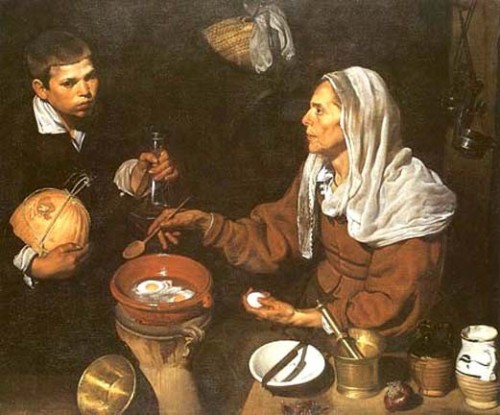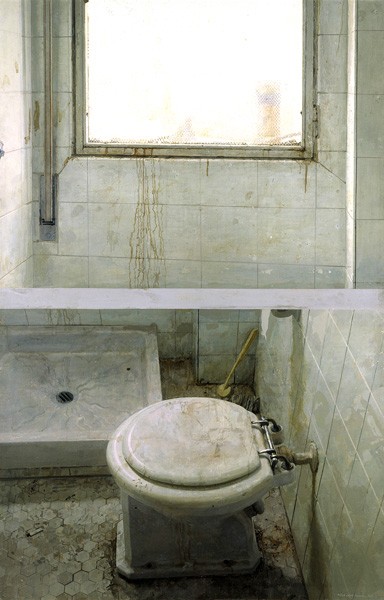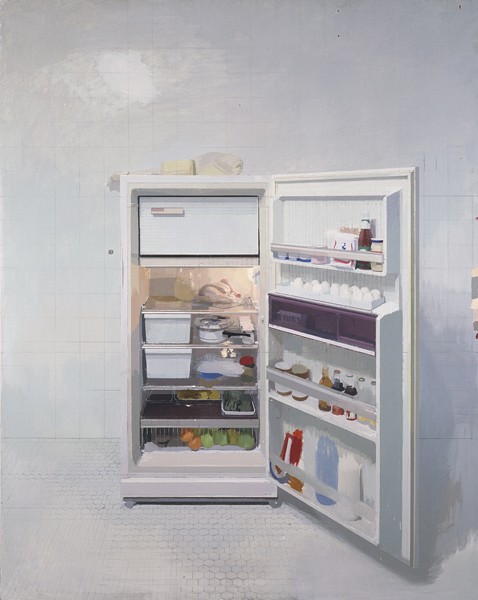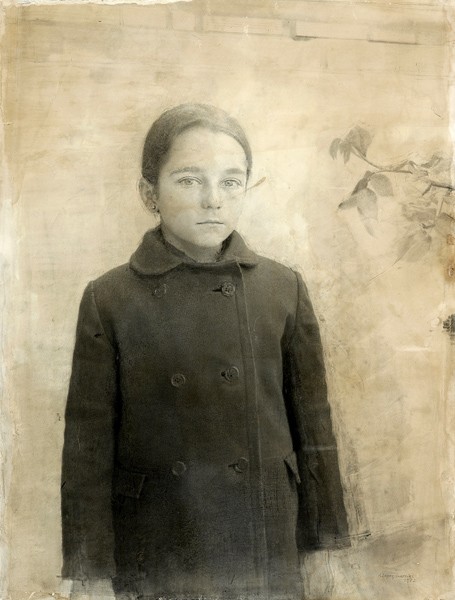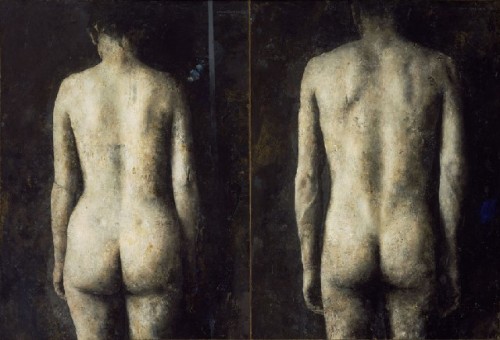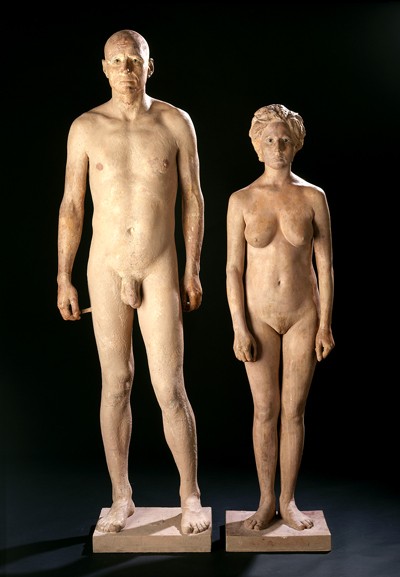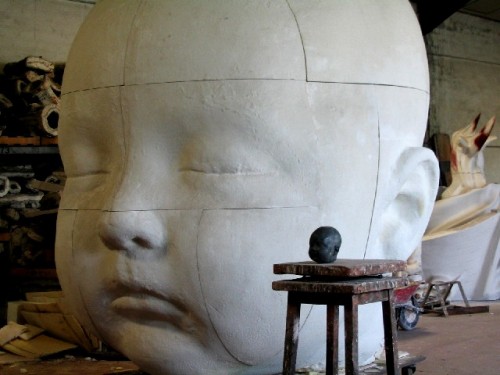A Man of La Mancha: Realist Antonio Lopez Garcia Featured at the Museum of Fine Arts
Celebration of Spanish Art Includes El Greco to Velasquez Art during the Reign of Philip III
By: Charles Giuliano - Jun 21, 2008
From now through July 27, the Museum of Fine Arts, Boston is featuring a remarkable selection of Spanish Old Masters "El Greco to Velasquez Art during the Reign pf Philip III". Entering the first gallery there is a stunning array of some of the finest works of the period many drawn from American museum collections. The Met has loaned its iconic "View of Toledo" and the National Gallery its galvanic "Laocoon" both by the anachronistic mannerist, El Greco.
After the initial impact of the first two galleries there is too much filler in the form of enervating stiff portraits of this or that Hapsburg infanta. There is an insightful mini survey of the unique development of still life painting. But there are way too many saints, even by El Greco. Too often Spanish art drowns in Catholicism. Even a great master like El Greco had reason to fear the terrors of the Inquisition. It all but smothered Spanish art until the Romantic Rebellion of Goya in the 19th Century. Resistance to the restraints of Spanish art and cultured inflamed the experimentation of Picasso in the 20th Century. His masterpiece "Guernica" is an anguished cry against the crushing conservatism of the Fascism of Franco and all its horrors.
While the exhibition bogged down with too many portraits of meticulously rendered pious monks it was in one of the final galleries that we were stopped in our tracks by an early DiegoVelasquez (1599-1660) "An Old Woman Cooking Eggs." He painted the work in 1618. Never having visited the National Gallery in Edinburgh, Scotland we knew this seminal work, influenced by the Baroque master, Caravaggio, only through reproductions. It was the treat and hidden treasure of this wonderful but uneven exhibition.
It is that same element of sober, tightly observed, realism that, jumping the centuries, informs the work of the contemporary realist, Antonio Lopez Garcia, born in 1936 in Tomelloso, in the La Mancha region of Spain. But this observer of the figure, landscape and still life is anything but quixotic.
Simply put, Lopez-Garcia is the most important contemporary Spanish artist whom you have probably never heard of. The primary reason for this involves the years that it takes to create meticulously rendered works. The Museum of Fine Arts exhibition represents the first American museum retrospective of the artist. Given the relative scarcity of the work this exhibition is a triumph by bringing together 55 paintings, drawings, and sculptures including two recent monumental bronze sculptures of a baby's head which flank the entrance of the MFA on Huntington Avenue..
The motive for the exhibition of this Spanish realist is that nine of the works on view, primarily early efforts by the artist, are derived from the permanent collection of the MFA. They were the most important and unique works in a large selection of artists given to the MFA by Melvin Blake and Frank Purnell. It is usual for museums to create special exhibitions around its holdings particularly when a specific artist is represented in depth. This provides the necessary leverage when negotiating loans.
It also suits the persona and strategy of the MFA that the work of Lopez Garcia in its meticulous realism is conservative and anachronistic as well as contemporary. In many ways the imagery is as dry as dust, literally. But also quirky in its fanatical observation and rendering of objects and interiors so ordinary and grungy that they channel the found objects and the deadpan dada of Marcel Duchamp. Given the factual and constrained approach of the artist, and his fellow Madrid realists, it would be a stretch to call this work in any way avant-garde. It is better to describe it as deeply and stridently Spanish in all of its reactionary, academic implications.
Like Picasso before him Lopez Garcia was a prodigy who, at 13, attended the renowned San Fernando Academy of Fine Arts in Madrid. Picasso, on the other hand, mostly skipped classes and hung out with his pals in the bars and brothels of Barcelona. While Picasso sought the liberation of Paris it appears that Lopez Garcia remained at home and was true to the heart and soul of Spanish art. Typically, the work is drained of color. Parched like the summer landscape bleached by the sun. Some of the most compelling works in the exhibition are large scale drawings of seemingly mundane subjects that required enormous time and labor in their meticulous executions. He ignored all international trends which is why he remained obscure and was discovered and celebrated past mid career. It also took many years to perfect his skills and produce a slim oeuvre. In general, representational artists evolve over a far greater span of time than their peers. Encountering a survey such as this, indeed a rare occasion and opportunity, the development of the work over time appears to be agonizingly incremental. It is fair to state that it has taken decades for the artist to fully develop and realize his skills and sensibility.
An early work in the exhibition owned by the MFA "Atocha," 1964, has a small scale couple fornicating in a bleak cityscape. There are some fascinating prepatory drawings which focus on the erotic pose. This narrative is far too specific and juicy and was an element that the artist seemingly purged from the subsequent work. A later painting presents a riveting view of a skinned rabbit on a plate with a delicate tonality of its flesh. There is a remarkable small scale painting of a bathroom sink with a shelf of ordinary toilet items. Or even more incredible and absorbing is a pencil rendering of the remains of a meal. It is the amazing aftermath of the typical still life in which the sumptuous food items have been consumed. It stands on its head the very notion of still life painting by presenting an existential exercise in entropy. The bleak and barren interiors that he lovingly renders often seem to channel the stark landscape of the set of "Waiting for Godot." Arguably, compared to the Theatre of the Absurd, Lopez Garcia is the Art of the Absurd. The art is redolent of a visualization of the trope of being and nothingness.
It is stated that it has taken him years to create his views of Madrid. The artist insists on painting only under similar conditions of season, weather and light. So he had to come back to the works over many years. This also entailed updating an ever changing urban environment. Old buildings are knocked down and new ones replace them. In that sense the artist works from direct observation and in this is different from the approach of photo realism. He is not just reproducing what is captured in a fraction of a second by the shutter of a camera. His views of the city with their obsessive detail are portraits in motion representing time and space. They are miracles of the mundane.
The array of work fills the Foster Galleries which mounts special exhibitions and spills out into the too small area devoted to the unremarkable permanent collection of modern and contemporary work. Scandalously, the MFA only started to collect contemporary art in 1971 and has done so in fits and starts ever since. The MFA is notorious as the least important modern and contemporary collection of any of the major American museums. It lags hopelessly behind the Philadelphia Museum with its seminal collection of Duchamp, the superb holdings of the Art Institute of Chicago, and even its conservative rival the Metropolitan Museum of Art. Its collection is eclipsed by the LA County Museum of Art which is truly ludicrous since the MFA was founded in 1870 and would seem to have had a running start. What a pity. The recent years of collecting under museum director Malcolm Rogers, with the notable exception of the Blake/ Purnell acquisitions, have been less than stunning. With the new construction designed by Lord Norman Foster the MFA will have more space for modern and contemporary art but filled with just what? Perhaps the America Cup yachts, empty wine bottles, and Frontier American souvenirs it displayed in the collection of its trustee William I. Koch. Perhaps there are surprises of acquisitions we don't know about being held back for the unveiling of the new galleries. The current curator, Cheryl Brutvan, has not been noted for risk taking either through special exhibitions or acquisitions.
The MFA is rightly known for its depth in American art. When the former director, Perry T. Rathbone was approached for advice on collecting by Maxim Karolik, a Russian opera singer and émigré who married an heiress of the Codman family, he was advised to focus on the then obscure and neglected period of the Post Civil War. The MFA eventually acquired great depth in works by the affordable and then undiscovered Martin Johnson Heade.
In 1990, the MFA was given the remarkable collection of early 20th century American modernism by William H. and Saundra Lane. They also have given the museum many seminal photographic works by Ansel Adams and other masters. In one great acquisition, orchestrated by former curator, Theodore E. Stebbins, Jr., the MFA moved to the forefront in this period with superb works by Arthur Dove, Stuart Davis, Georgia O' Keeffe, Charles Sheeler, Charles Demuth, the neglected Boston masters Hyman Bloom and Karl Zerbe, as well as early works by the abstract expressionist Franz Kline. Prior to this very little of that era was in the collection. In one step the museum evolved from rags to riches. Thanks to the generosity of the Lanes.
While the Blake/ Purnell Collection represents a major acquisition it is hardly the spine around which to construct a position in 20th century Modernism worthy of a museum of its status. At best, it is an interesting, quirky, sidebar representing the style and taste of collectors who were off the radar screen of the field. In terms of depth and quality Lopez Garcia is the most interesting and important artist in the Blake/ Purnell gift to the MFA.. But he proves to be the maverick, eccentric of modernism and contemporary art rather than a signifier to build around. In this case Lopez Garcia and what adds up to two? With his work as an anchor what next? More realists? Well, perhaps, but it would be an odd strategy that ignores the primary masters and movements of contemporary art. It is a luxury that the Met can afford given the range and superb selection of its holdings. In his talk at the Clark last winter the former director of the Met, Philippe de Montebello, discussed how only the relatively few and very best examples of contemporary art would honor its encyclopedic collection. By comparison the MFA is desperate and needy.
There are many joys to be had in the current survey of Lopez Garcia. Given the rarity of the oeuvre it is an occasion not likely to be repeated. He is a truly remarkable poet and master of the ordinary. What is most enjoyable is the austerity and humility of the work. There are other realists with technique on this level. Andrew Wyeth is an old favorite of the MFA. But he is far too much the son of his illustrator father N.C. Wyeth. By today's standards too much of the work is corny. Richard Estes is a realist whose skills in rendering the most meticulous architectural detail are on a par with the obsessive compulsive views of Madrid by Lopez Garcia. But compared to the subdued works by the Spanish master the color of Estes is so saturated and pop that they are Kodak moments. There is none of the nuance we find in the canvases of Lopez Garcia that slow us down to a crawl as we creep over the surfaces absorbing the minute detail. Compared to which the paintings of Estes jump out and overwhelm us. Estes is a great painter while Lopez Garcia is a more meditative poet and thinker. The work is about far more than its immediate and obvious skill in rendering.
Mostly I regard Lopez Garcia as a master of drawing and form. It is a conservative tradition rooted in the academy that evolved with David and then Ingres. In the obsession with volume and rendering what typically gets lost is the freshness of color. Perhaps this is why the most compelling works on view are the pencil drawings, created on enormous scale and presented like paintings, as well as, the examples of sculpture.
The sculptures don't do much. There is little investment in gesture, pose and movement. The pair of a nude male and female couple just stand there in a pose that is as ancient as Archaic Greek Kouros and Kore figures or, before that, the Standing Egyptians of the Old Kingdom. But those, my friends, are not bad comparisons. There is that same level of intensity, the sublime, classical, and Apollonian. Lopez Garcia is all of that. Which also makes him an eccentric and anachronist. Indeed, he is one of our greatest living masters but just not of our time. Or rather, his work is truly timeless.

